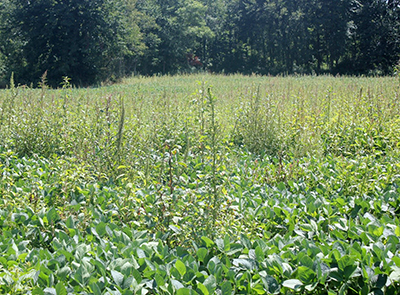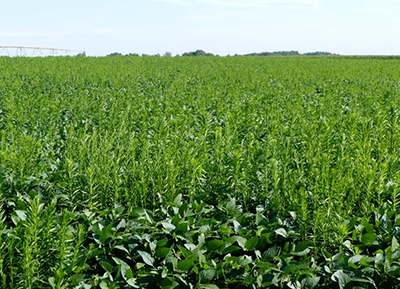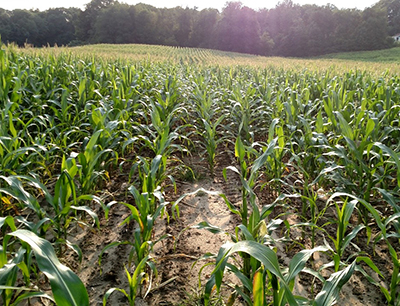Southwest Michigan field crop update — Aug. 10, 2017
While we did receive welcome rainfall last week, conditions are still dry enough for spider mites to gain a foothold in some soybean fields.

Weather
Some much needed rain fell before and during the weekend of Aug. 5. However, rainfall has been scarce again this week. There is a 30 percent chance of showers during the overnight hours on Aug. 10, then dry conditions are expected through much of next week.
The NOAA 6-10 day outlook shows below normal rainfall and cooler than normal temperatures. The 8-14 day period is expected to be slightly above normal precipitation and much above normal temperatures to end the month of August.
Crop water usage
We are in the last few weeks of peak water use for corn and soybean. Total crop need is 120 percent of potential evapotranspiration (pET) values, or approximately 1.3 inches of water use per week. Look to taper off irrigation in one to two weeks for corn (through R4 dough stage) or three weeks for soybean (through R6, full seed). See the Michigan State University Extension article, “Mid-July results in peak water use for most field crops,” for more information on irrigation issues this season.
Defoliation in seed corn will begin in some fields next week while male row destruction is nearing completion in others. For those thinking about interseeding a cover crop into a standing seed corn field, time the seeding such that the cover crop has not yet germinated by the time any defoliation product has been applied. You can seed either just prior to defoliation (check germination time for the species you are planting) or wait until afterwards.
Pest conditions
Dry conditions have allowed spider mites to gain a foothold in some soybean fields, mainly along dusty field edges. While we did receive some welcome rainfall late last week, it was apparently not enough to kick-start the pathogenic fungi that helps control their populations. Keep an eye out for expanding areas of yellowing, bronzing or leaf loss. We may be able to treat field edges, but only if you do not find “hot spots” of mite damage in the interiors of the fields.
Lots of insecticides control mites. Most will not, however, control eggs. Rainfall is the ultimate prescription. For more information, please review “Spider mite spraying in Michigan field crops” by MSU field crops entomologist Christina DiFonzo.

Spider mite infestation in southwest Michigan soybean field. Photo by Bruce MacKellar, MSU Extension.
We are seeing substantial increases in herbicide resistant common waterhemp and marestail in fields in southwest Michigan. We all know what marestail looks like, but identifying waterhemp can be a bit more challenging. Look out for patches or individual weeds of the pigweed species that escaped herbicide applications. Common waterhemp does look like a pigweed, but in general it has narrower leaves than other pigweed species. It differs from Palmer amaranth in appearance, as the leaf petioles are about the same length as the leaves, rather than longer in Palmer. It is similar to Palmer in the fact that this pigweed species does not have hairs on the stem, and it also has both male and female plants with different looking flowers.

Herbicide-resistant common waterhemp in an Allegan County soybean field. Photo by Bruce MacKellar, MSU Extension.
Waterhemp tends to have more branching in the flowers and seedheads than other pigweed species. If you find small pockets of either Palmer amaranth of common waterhemp in your fields, it is possible you are seeing a first-year infestation. Consider removing the plants by hand, bagging them and removing them from your fields. Containing small patches of plants can be a good way of helping to reduce the seed bank of these hard-to-control weed species.
Rotating the field to corn and using herbicide programs that control waterhemp, such as atrazine or callisto, can help control the weed species. When rotating back to soybeans, consider planting liberty link soybeans. MSU weed control specialist Christy Sprague has a list of considerations for controlling multiple herbicide resistant Palmer amaranth and waterhemp in soybean fields at “Multiple herbicide-resistant Palmer amaranth and waterhemp in Michigan.” A factsheet on ways to control herbicide-resistant marestail is available at “Herbicide-resistant horseweed (marestail) in Michigan.”

Herbicide-resistant marestail infested soybean field in St. Joseph County. Photo by Bruce MacKellar, MSU Extension.
Asiatic garden beetle white grub damage to corn following soybeans was rampant in many fields in Van Buren and Cass counties this spring. Symptoms primarily were uneven stand height. Some of this corn will suffer substantial yield losses this fall (15 percent or more). Soil insecticides may have to be used if your fields have high number of white grubs in the spring.

Pocket of white grub damage from Asiatic garden beetles in Northern Cass County. Photo by Bruce MacKellar, MSU Extension.
Western bean cutworm larvae have completed their journey into the corn ears. The larvae are still relatively small. Feeding damage on ear tips and through husk should become evident in the next week to 10 days. It is a little too early to tell what percentage of ear infestation will be this season. Egg mass predation/pathogen load was very low in egg masses we observed, with very little early larval mortality.

Western bean cutworm larvae in developing ear. Photo by Kevin Chase.



 Print
Print Email
Email


